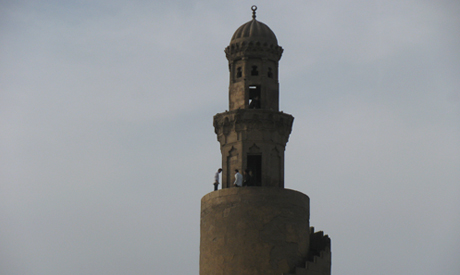
Mosque of Ibn Tulun (Photo: Amira El-Noshokaty)
Walking in the city victorious can be quite a challenge. And delving into the heart of Sayida Zeinab district can be a bit overwhelming. But as my high school teacher once wisely explained: when walking, one’s sight should not separate the land from the sky. Adopting the same attitude, I joined one of the walks held by Al-Athar Lina (The Monument is Ours) project.
Al-Athar Lina is based in Al-Khalifa Street, which runs between Ahmed Ibn Tulun Mosque in Sayyida Zeinab and the Shrine of Sayyida Nafisa. The project aims to teach local residents about the monuments they live among so they can appreciate them and help preserve them. It does this by scheduling walks, workshops and interactive activities to explain the social history of the area.
Al-Khalifa Street begins with Ibn Tulun Mosque. Completed in 879, the mosque has spiral-shaped minarets that look down on Al-Zeiada (The Extra), a spacious front yard that can hold over 10,000 people. The façade is crowned with 128 pointed arch windows, each of which has a different internal design.
The mosque was commissioned by Ahmed Ibn Tulun, Abbasid governor of Egypt from (868-884 AD). Though constructed in the Samarran style (Iraq), it has authentic Egyptian architectural symbols on its walls.
Subtly tucked between each window is a shell-like engraving, the stamp of Coptic (Ancient Egyptian) architecture. “In Coptic history shells and eggs are symbols of protection and bonding to the place they are engraved on, usually houses of worship,” explained tour guide Nabil Attia.
At the right time of day, the lace-like windows allow daylight to dance around the ancient ground. “Here the windows are intentionally a bit off centre from the pointed arches,“ said tour guide Tarek Sewailam.
He added: “The art of architecture is based on movement. So with each angle, you find a nice angle to view. This is what makes one want to stay inside a building, it was built by someone who loves it.”
In the centre of the courtyard is a unique domical building. The Fawara is where ablutions would take place before Friday prayers. It’s also where young children were kept during prayer time. After Friday prayers, Al-Waraq (paper man) would hand out papers and crayons for the young children to draw, scribble and learn the basics of Arabic calligraphy.
But the ancient mosque, like many Egyptian monuments, has had its own share of neglect. Over the years, haphazard houses were built nearby.
“From 1890 to 1956, the only access to the mosque was through the kitchens of the neighbours. The antiquities ministry then took over and it was restored,” Sewailam explains.
On one side of the mosque is the famous Gayer-Anderson Museum.
The well-preserved 17th century building was first owned by women from Crete, and was called House of Al-Ceretlia. Later it was bought by Major Gayer-Anderson, a retired British officer and orientalist, who lived there from 1935 until 1942. With its arabesque windows and mahrabiyas, it is not difficult to relive the oral myths he collected and compiled in a book that was translated into Arabic by his grandson a few years ago.
A few blocks down the small road is the mausoleum of Sultana Shagar Al-Dor (trees of pearls), the widow of Ayyubid Sultan Al-Saleh Ayoub (1249-1250 AD), who became Egypt’s Sultana in 1250.
Inside the mausoleum, and on one of the domes, you can still see the golden mosaic patterns, the only ones in history that reflect the name of its owner: drawings of trees of pearls.
Al-Athar Lina (phase three)project is the result of collaboration between the American research center in Egypt, the British Council and Barakat Trust.
Short link: